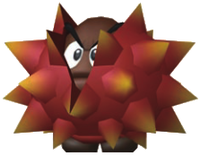Chestnut
It has been requested that more images be uploaded for this article. Remove this notice only after the additional images have been added. Specific(s): ingame appearances
| Chestnut | |||
|---|---|---|---|
 Artwork of a Prickly Goomba, a Goomba using a chestnut shell | |||
| First appearance | Wario Land 3 (2000) | ||
| Latest appearance | Paper Mario: The Origami King (2020) | ||
| |||
Chestnuts are a type of tree fruit known for their hard, spiny cupules containing the edible seed portion. In the extended Super Mario franchise, chestnut shells occasionally appear as obstacles.
History[edit]
Wario Land 3[edit]
In Wario Land 3, chestnuts are conjured up by Wolfenboss, bouncing on the ground when they land. They break open after a few moments, letting the Kuri inside free, then disappear. If Wario touches one, he turns into Puffy Wario, evicting him from the battle.
Donkey Kong Jungle Beat[edit]
In Donkey Kong Jungle Beat, red chestnuts are used as harmful projectiles by Coco Pigs and both types of Mini Slump Bird. Unlike coconuts, they cannot be knocked back at the enemy. In Aurora Glacier, Coco Pigs instead throw smooth ice balls, though these are made spiky as well in New Play Control! Donkey Kong Jungle Beat.
Super Mario series[edit]
In New Super Mario Bros. Wii, New Super Mario Bros. U, New Super Luigi U, and New Super Mario Bros. U Deluxe, chestnut shells are used as armor by Prickly Goombas. They hurt anyone except Yoshi that tries to jump on them, but can be burned away by a fireball.
Paper Mario: The Origami King[edit]
In Paper Mario: The Origami King, chestnuts appear as obstacles in Chestnut Valley. They often roll down the hills, and damage Mario if he makes contact with them. Mario can avoid them by taking cover in gaps in the walls. At one point, Galoombas break out of chestnuts and engage Mario in battle.
Names in other languages[edit]
| Language | Name | Meaning | Notes |
|---|---|---|---|
| Japanese | イガグリ[1] Igaguri |
Shelled Chestnut | |
| Italian | Castagna[?] | Chestnut |
References[edit]
- ^ Wario Land 3: Fushigi na Orgel Shogakukan guide, page 124.